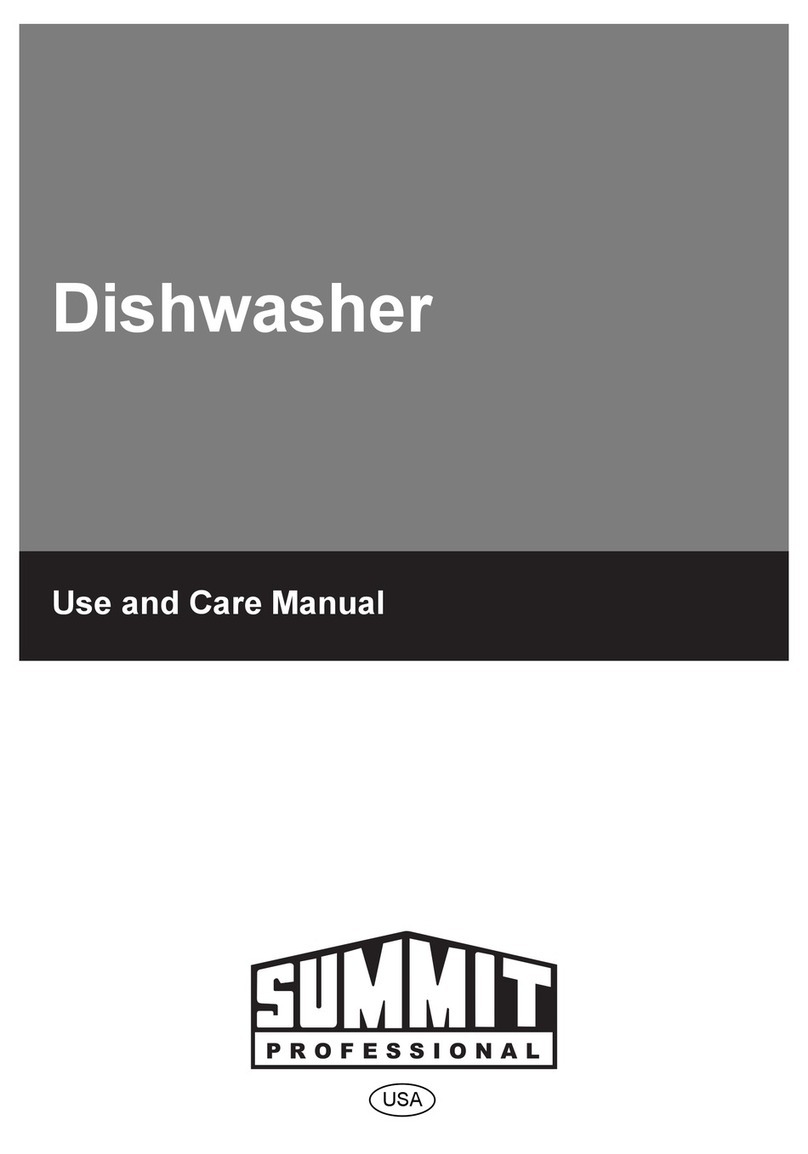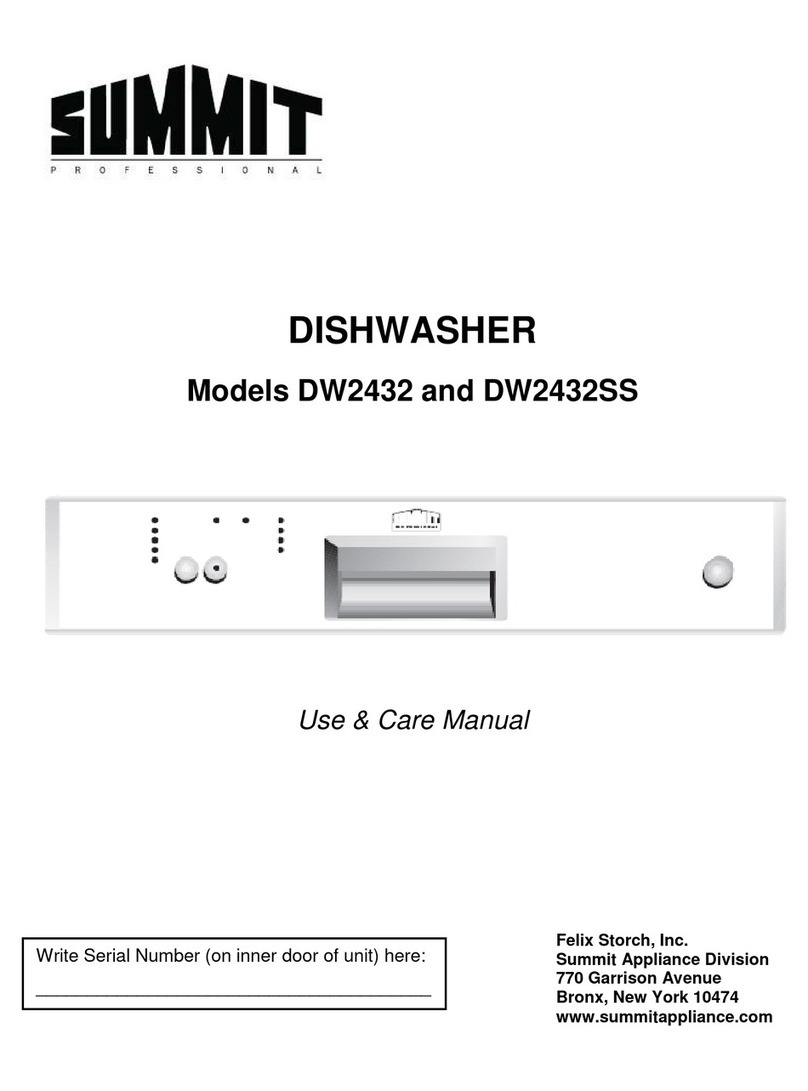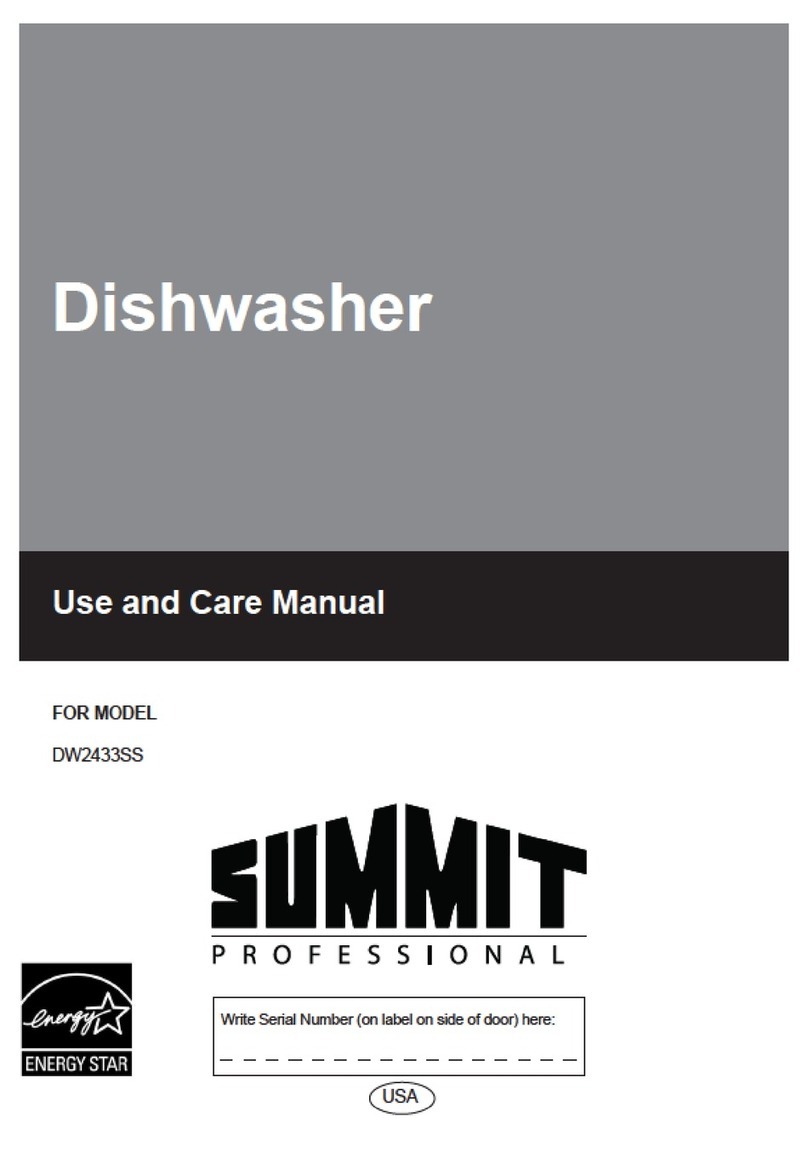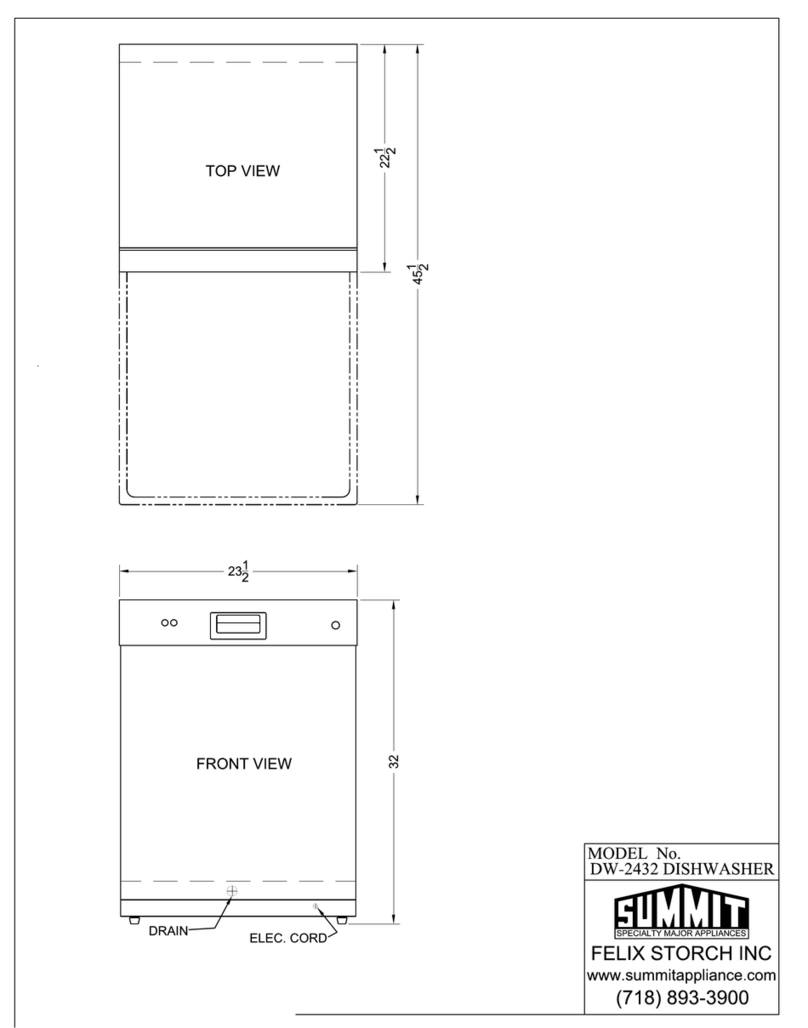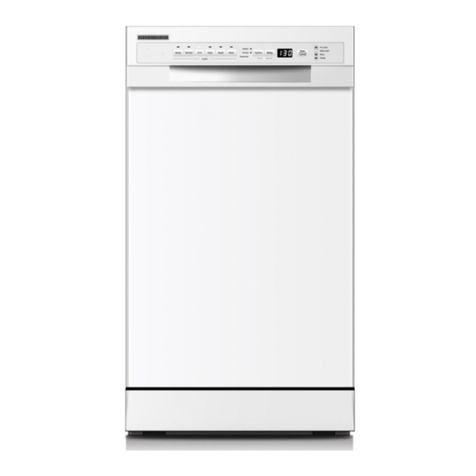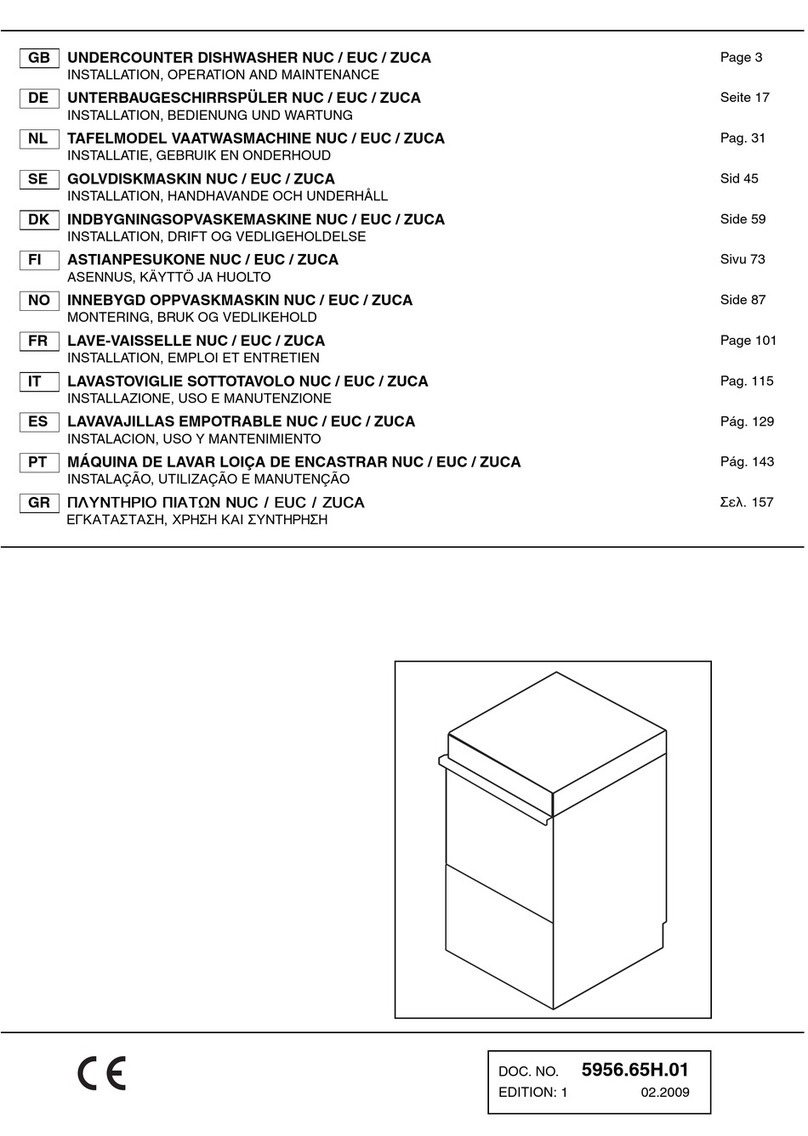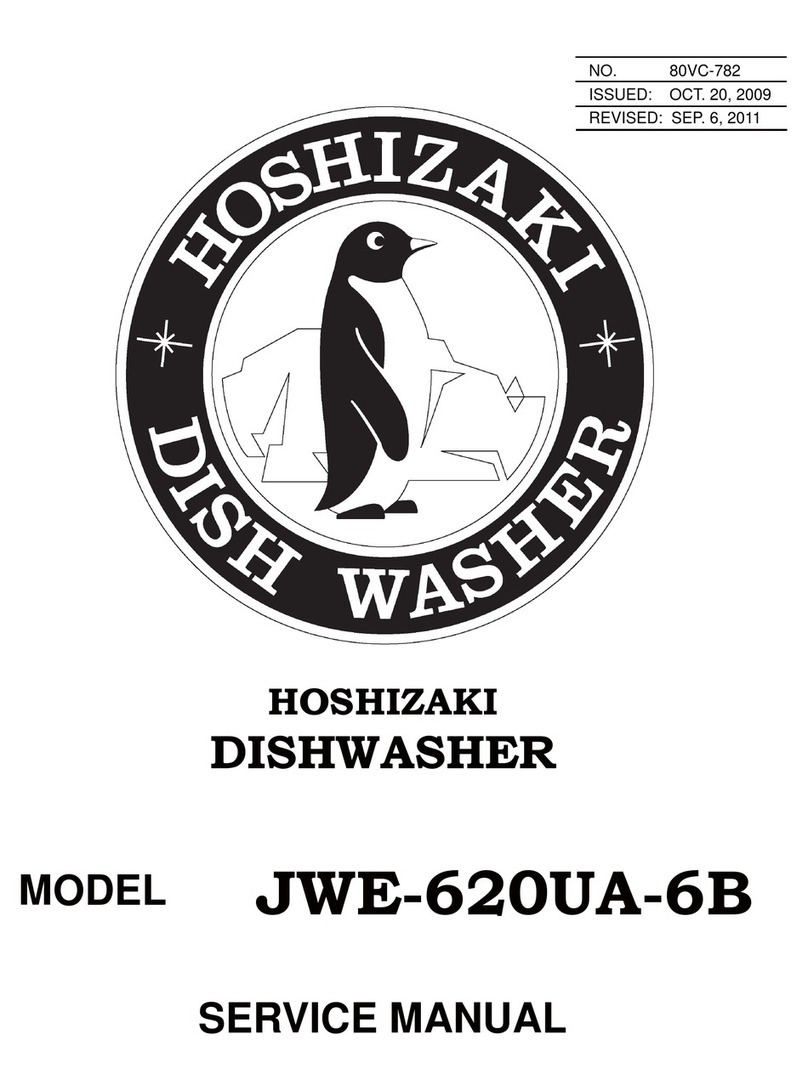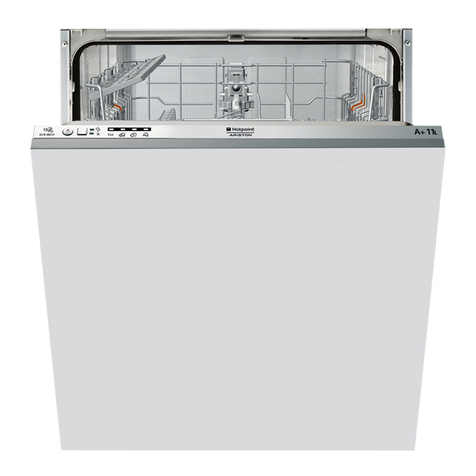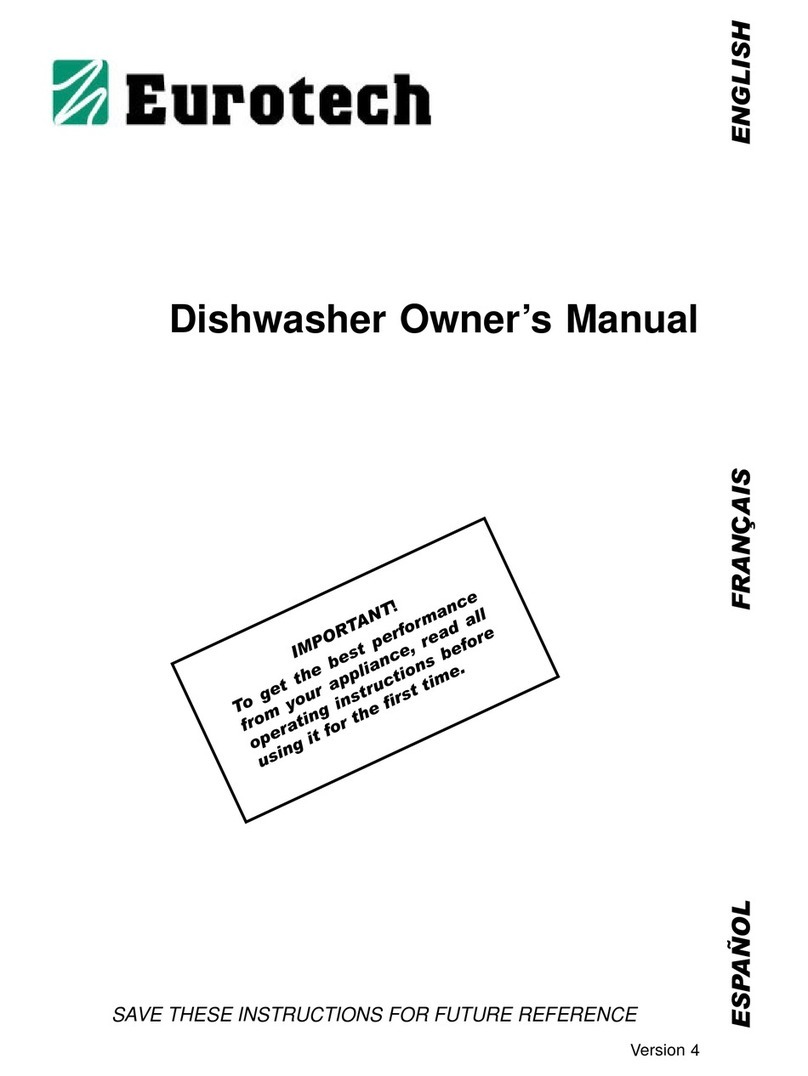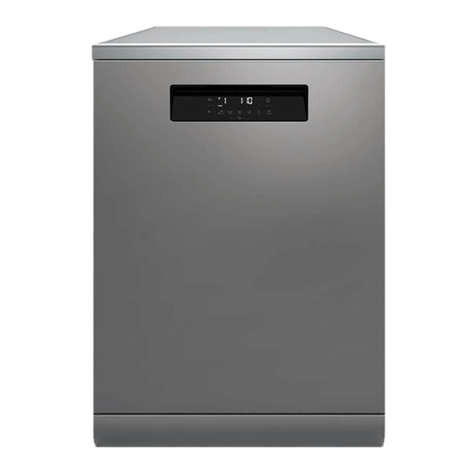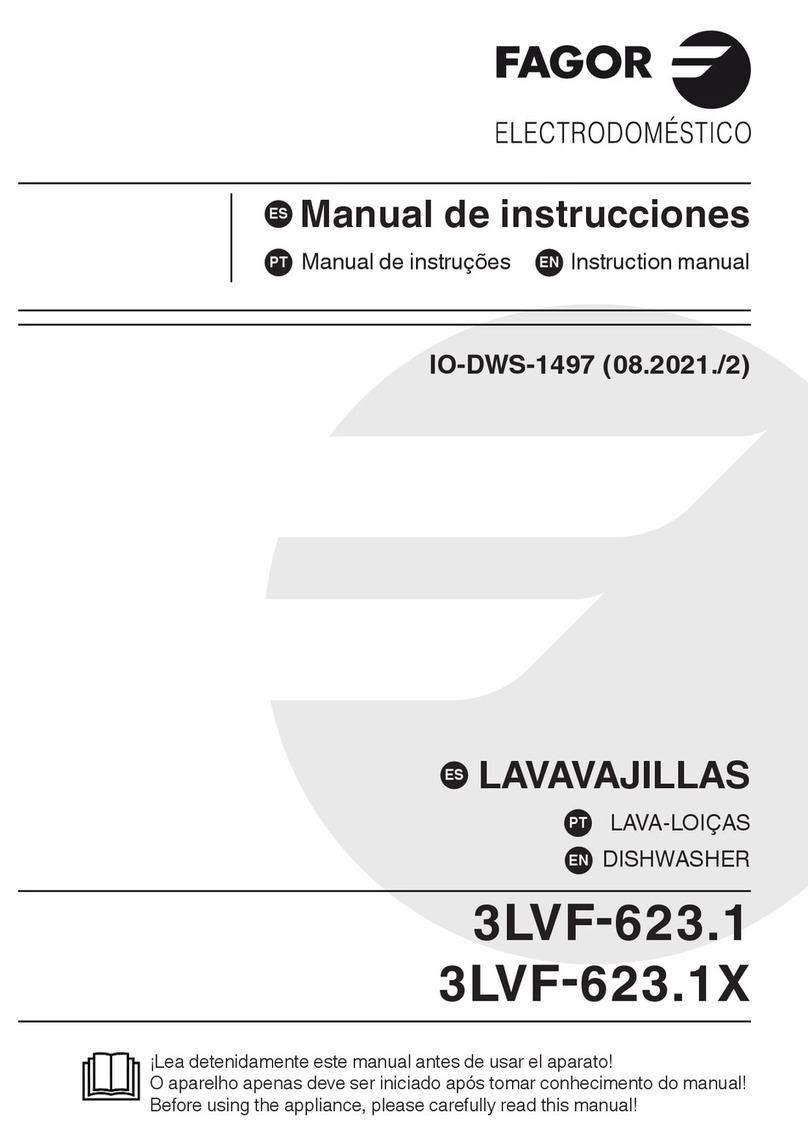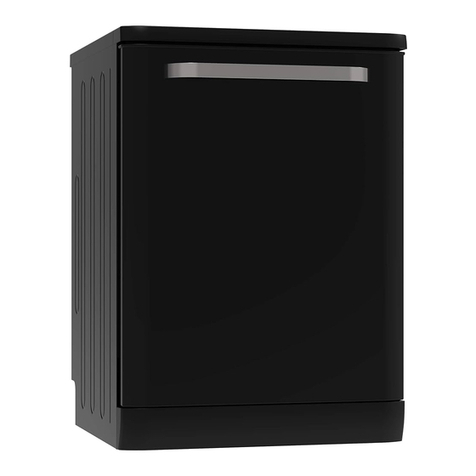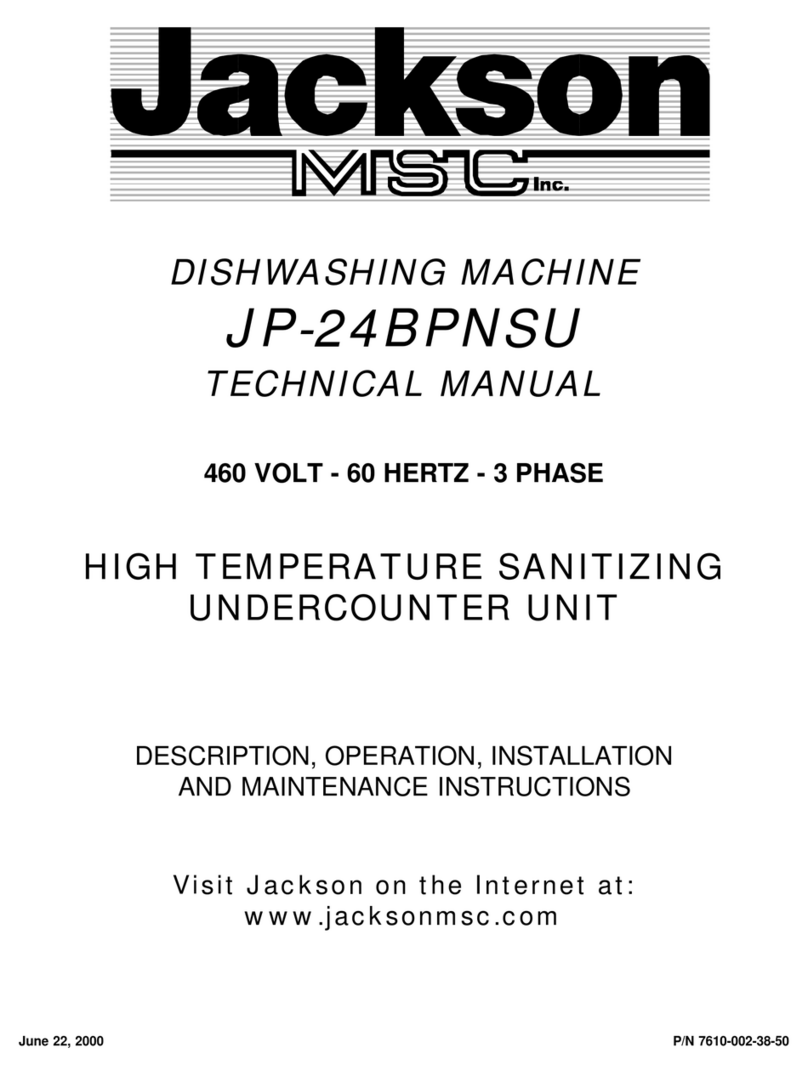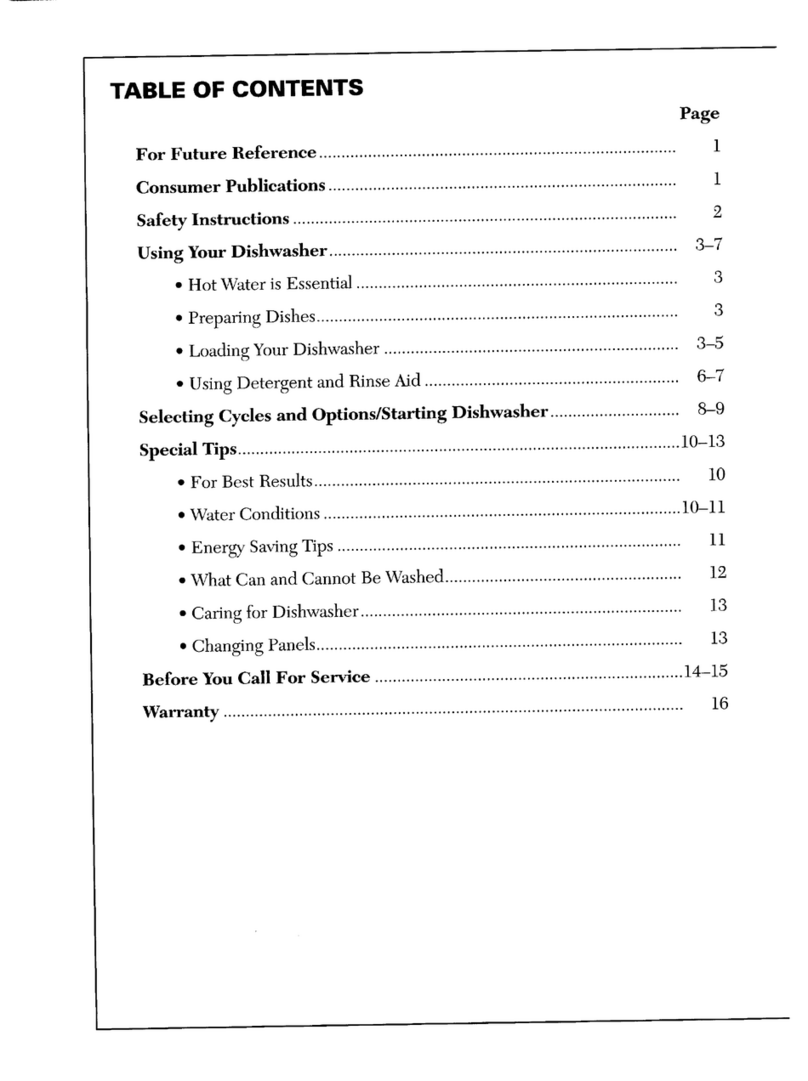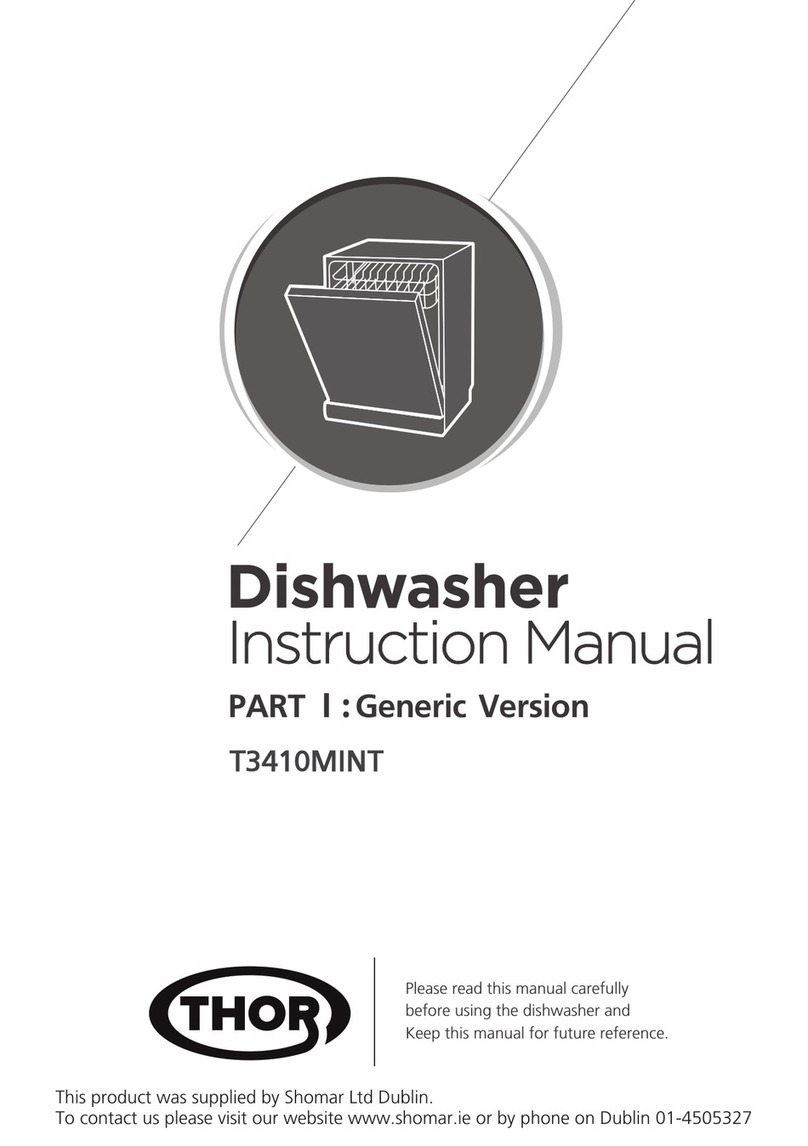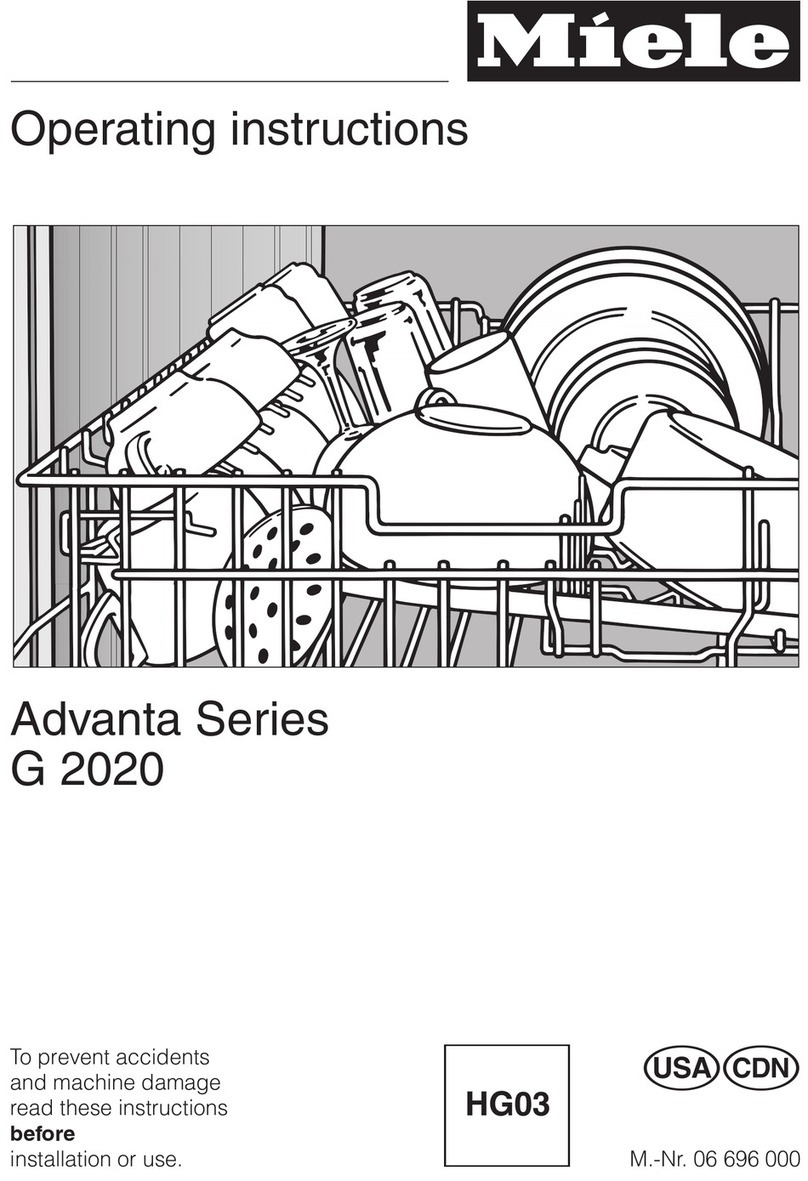Summit DW242WADA User manual

DISHWASHER
Models:
DW242WADA
LDW24WA
DW242W
ADADW24W
DW243BADA
LDW24BA
DW243B
ADADW24B
DW245NTADA
LDW24NTA
DW245NT
ADADW24NT
User Manual
BEFORE USE, PLEASE READ AND FOLLOW ALL SAFETY RULES AND OPERATING
INSTRUCTIONS

2
TABLE OF CONTENTS
Important Safety Instructions 4-6
Installation 7
Technical Information 8
Before Using your Appliance 9-14
Preparing your Dishwasher for First Use 9
Setting the Water Softener 9-10
Filling the Salt Dispenser 11
Detergemnt Usage 12
Filling the Detergent 12-13
Using Combined Detergents 13
Water Temperature 13-14
Dilling the Rinse-Aid and Setting 14
Loading your Dishwasher 15-20
Upper Rack 16
Lower Rack 16-17
Incorrect Loads 17
Adjustable Top Rack 18
Height Setting 19-20
Lower Rack Folding Arms 20
Silverware Basket 20
Programs and Options Table 21
Operating your Appliance 22-26
Control Panel 22
Keys 22
Preparing the Machine 23
Program Selection 23
Auxiliary Functions 23-24
Programming the Wash Time 24-25
Starting the Program 25
Cancelling the Program 25
Salt Indicator 25
Rinse-Aid Indicator 25
End of Program 25
Water Cut-off Warning 26
Overflow Warning 26
Maintenance and Cleaning 26-27
Filters 26
Spray Arms 27
Cleaning the Impellers 27
What Should Not be Washed 28
Troubleshooting 29-30
Automatic Fault Warnings 31
Limited Warranty 32

3
Thank you for choosing this product.
This User Manual contains important information on safety and instructions intended to assist
you in the operation and maintenance of your appliance.
Please take the time to read this User Manual before using your appliance and keep this book
for future reference.
Icon
Type
Meaning
WARNING
Serious injury or death risk
RISK OF ELECTRIC
SHOCK
Dangerous voltage risk
FIRE
Warning; Risk of fire / flammable
materials
CAUTION
Injury or property damage risk
IMPORTANT / NOTE
Operating the system correctly

4
INTRODUCTION
•Please read this user manual, particularly the safety instructions completely and carefully. They
will save you time and effort and helpto ensure optimum dishwasher performance.
•Be sure to observe all listed warnings and cautions. Look for the icons with exclamation marks
inside. The information icon will also provide important references.
WARNING: Indicates a potentially hazardous situation which, if not avoided, could result in death
or serious injury.
CAUTION: Indicates a potentially hazardous situation which, if not avoided, may result in injury. It
may also be used to alert againstunsafe practices.
NOTICE: Indicates a potentially hazardous situation which, if not avoided, may result in damage
to the dishwasher, the tableware, theequipment or the environment.
IMPORTANT SAFETY INSTRUCTIONS
WARNING: When using the dishwasher, follow basic precations.Read all instructions before
using the dishwasher! Save these operating instructions and pass them on to any future user.
•Use the dishwasher only for its intended purpose as described inthis user manual. This
appliance is intended for normal householduse only. Do not change the specification of the
appliance. The manufacturer disclaims responsibility for damage or injury caused by
improper use of this appliance.
•The information in this user manual must be followed to minimizethe risk of fire or explosion and
to prevent property damage, personal injury or loss of life
•Use only detergents or wetting agents recommended for use in adishwasher and keep them out
of the reach of children.
•When loading items to be washed:
1. Locate sharp items so that they are not likely to damage the doorseal, and
2. Load sharp knives with the handles up to reduce the risk of injuries.
•Do not wash plastic items unless they are marked
•“dishwasher safe”or the equivalent. For plastic items not so marked,check the manufacturer’s
recommendations.
•Do not touch the HEATING ELEMENT during or immediately afteruse.
•Do not operate your dishwasher unless all ENCLOSURE panelsare properly in place.
•Do not tamper with controls.
•Do not abuse, sit on, or stand on the door or dish rack of thedishwasher.
•The cup racks are designed to support cups, glassesand kitchenutensils.When the cup racks are
in the dishwasher, do not lean onor use the cup racks to support your body weight.
•This appliance must be grounded. In the event of a malfunction orbreakdown, grounding will
reduce the risk of electric shock by providing a path of least resistance for the electric current.
This appliance is equipped with a cord having an equipment-grounding conductor and a
grounding plug. The plug must be plugged into anappropriate outlet that is installed and
grounded in accordance withall local codes and ordinances.

5
WARNING:
Improper connection of the equipment-grounding conductor can result in a risk of electric shock.
Check with a qualified electrician or service representative if you are in doubt whether the appliance
is properly grounded. Do not modify the plug provided with the appliance. If it will not fit the outlet,
have a proper outlet installed bya qualified electrician.
•Some dishwasher detergents are high in alkaline. They can be extremely dangerous if
swallowed.Avoid contact with the skin and eyes and keep children and infirm persons away from
the dishwasher when the door is open.
•Consult a doctor immediately if detergent has been swallowed or inhaled.
•Do not remove the dishes from the appliance until the program iscomplete. Some detergent may
remain on the dishes.
•Check that the detergent dispenser is empty after the completion of each wash program.
•Do not drink and play with the water in the appliance; harmfulresidues could be present.
•To reduce the risk of injury, do not allow children to play in or on
•the dishwasher.
•When children become old enough to operate the appliance, it isthe responsibility of the
parents/legal guardians to ensure the children are instructed in safe use practices.
•Do not leave the appliance with the open door unattended to avoid stepping accidentally onto
it.
WARNING: Before any maintenance is performed, deactivate the appliance and disconnect
the main power plug from the socket.
•Do not use high pressure water sprays and/or steam to clean the appliance.
•Ensure that there are no visible water leaks during and after the first use of the appliance.
•To avoid floor damage and possible mold growth, do not allow wet areas to remain around or
under the dishwasher.
•To avoid dishwasher damage, do not allow water to remain in your dishwasher systems
through extended periods of freezing.
RISK OF INJURY: To avoid risk of injury, always use caution when opening the door during or
following a wash cycle as hot water or steam may escape.
•Do not store or use flammable liquids or vapors on, near, or in the area of the appliance.
•Under certain conditions, hydrogen gas may be produced in a hot-water system that has not
been used for two weeks or more. HYDROGEN GAS IS EXPLOSIVE. If the hot-water system
has not been used for such a period, before using the dishwasher turn on allhot-water faucets
and let the water flow from each for several minutes. This will release any accumulated
hydrogen gas. As the gas is flammable, do not smoke or use an open flame during this time.
•Please check the water supply line periodically. It is susceptible to breakage. It becomes less
flexible as time goes by. Replace it immediately when it is torn, cut, swollen or there is water
leakage.

6
RECYCLING
Remove the door to the washing compartment when removing anold dishwasher from service or
discarding it. Ensure that the appliance presents no danger to children while being stored for
disposal. Before disposing the dishwasher:
•Disconnect the appliance from the main power supply.
•Cut off the mains cable and discard it.
•Remove the door catch to prevent children and pets from being closed in the appliance
Old appliances may contain materials that cannot be recycled. Please contact your local recycling
authority about the possibility ofrecycling these materials.
Please check the water supply line periodically. It is susceptible to breakage. It becomes less flexible
as time goes by. Replace it immediately when it is torn, cut, swollen or there is water leakage.
Please keep the dishwasher package out of the reach of childrenafter unpacking it.
WARNING!:
Risk of injury or suffocation! Ensure that any plastic wrappings,bags, small pieces etc. are
disposed of safely and kept out of the reach of children.
SAVE THESE INSTRUCTIONS

7
INSTALLATION
WARNING: When installing the dishwasher, follow basic precautions, please check the standards
and local codes for placement of machine.
•Installation, maintenance and repair should be performed by a qualified installer. Work by
unqualified persons could be dangerous and may void the warranty.
•Do not operate the appliance if damaged, malfunctioning, partially disassembled or if it has
missing or broken parts.
•Before installation or service, disconnect the power supply to the work area by unplugging the
unit, “tripping” the circuit breaker or removing the fuse.
•Only connect the dishwasher to the power supply when all installation and plumbing work is
complete.
•Never connect the ground wire to gas lines, hot water pipes, or plumbing lines.
•Do not install or store the dishwasher where it can be exposed tobelow freezing temperatures or
exposed to weather.
•Dishwasher must be secured to adjacent cabinetry using the brackets provided. Failure to do
this may cause damage to propertyor bodily injury.
•Connect to a properly rated, protected and sized power supply circuit to avoid electrical
overload. The dishwasher is designed foran electrical supply of 120 V (volts), 60 Hz (hertz),
•AC, connected to a dishwasher-dedicated, properly grounded electrical circuit with a fuse or
breakers rated for 15 amperes. Electrical supply conductors shall be a minimum of # 16 AWG
copper wire rated at 75 °C (167 °F) or higher. These requirements must be met to prevent injury
and machine damage. Consult a qualified electrician if in doubt.
•Do not use any extension cord or portable outlet device to connectthe dishwasher to a power
supply.
WARNING: Danger of suffocation! Ensure that any plastic wrap-pings, bags, small pieces etc.
are disposed of safely and keptout of the reach of children.

8
TECHNICAL INFORMATION
1. Upper basket with racks
2. Upper spray arm
3. Lower basket
4. Lower spray arm
5. Top nozzle( Model Depending)
6. Filters
7. Rating plate
8. Control panel
9. Detergent and rinse-aid dispenser
10. Salt dispenser( Model Depending)
11. Upper basket track latch
12. Drying Unit: This system provides better drying
performance for your dishes.
Permissible
water
pressure
43.5-145psi
(0.3 - 10
bars)
Electrical
connection
120 V
(volts), 12
A (amps),
60Hz
(hertz)
Total power
1400 (W)
Heater power
1100 (W)
NOTICE: Because we continually strive to improve our products, we may change our
specifications and design without prior notice. This device corresponds to the following directives: UL
749 Household Dishwasher directive.

9
BEFORE USING YOUR APPLAINCE
Preparing Your Dishwasher for the First Use
•Make sure the electricity and supply water specifications match the values indicated in the
installation instructions for the machine.
•Open the door of the dishwasher.
•Remove all packaging material inside the machine.
•Set the water softener level. (See chapter of setting the water, model depending).
•Set the rinse aid dosage (See chapter of filling the rinse-aid and setting).
•Fill the salt container (see chapter of filling the dishwasher salt dispenser, model depending).
•Fill the rinse aid compartment. (See chapter of filling the rinse aid and setting).
•Place the dishes in accordance with the instructions in the user manual.
•Put adequate amount of detergent into the detergent dispenser. (See chapter of filling the
detergent).
•Make sure that the upper and lower impellers rotate freely.
•Select program according to amount of dirt (See chapter of Program table).
•Close the door of the dishwasher. (Push the baskets in. Then lift the door upwards and push
until it clicks into position).
CAUTION: To prevent injuries, ensure that your hand is not jammed or crushed between the
door and appliance
WARNING: While the appliance is running, if you open the door, all functions are automatically
interrupted
CAUTION: There may be escape of hot steam when you open the door of your machine. Be
careful of getting injured.
Setting the Water Softener (Model Depending)
•The dishwasher needs soft water for good cleaning results. Hard water results in a build-up of
calcium deposits on dishware and in the dishwasher. Your dishwasher has a special water
softening system to remove the hardness of the tap water. Setting this system correctly will
increase the washing effectiveness.
•Water supplies with a hardness level higher than 9 °f (French Water Hardness) needs to be
softened.
•If the hardness level of the water that you use is above 9 °f (French standard for water hardness)
or if you are using well water, than it is recommended to use a filter and water purification
devices.
•The dishwasher is programmed at the factory setting level 1 (inactive) of water hardness. If this
setting corresponds to the hardness of your water, you do not need to do anything more.
•The dishwasher must be programmed for the water hardness in your area.
•To find out the hardness level of water in your area, contact your local Water Board or Determine
water hardness level by the help of test strip provided.
WARNING: If you move to a different location, the level of water hardness will possibly be
different. It is essential to setting again the water hardness in order to obtain optimum washing
efficiency.

10
Test Strip (For Models With Water Softener)
The washing effectiveness of your machine depends on the softness of the tap water. For this
reason, your machine is equipped with a system that reduces the hardness in the main water supply.
The washing effectiveness will increase when the system is correctly set. To find out the water
hardness level of water in your area, contact your local water board or determine water hardness
level by using the test strip (if available). Follow the steps in the image when use the test strip.
WARNING: If the water is well water or has a hardness level above 9 °f, werecommend that you
use filter and refinement devices.
Water Hardness Table
Level
German °dH
French °f
British °E
Indicator
1
0-5
0-9
0-6
L1 is shown on the display.
2
6-11
10-20
7-14
L2 is shown on the display.
3
12-17
21-30
15-21
L3 is shown on the display.
4
18-22
31-40
22-28
L4 is shown on the display.
5
23-31
41-55
29-39
L5 is shown on the display.
6
35-50
56-90
40-63
L6 is shown on the display.
Adjust the water hardness setting of your machine according to the level specified on the test
strip (if available).
NOTE: Hardness level is adjusted to level 1 as a factory setting.
NOTE: If you only ever use combination products in your dishwasher, you can change the
softener level.
Salt Indicator
Please check the salt indicator on the control panel to see whether there is adequate amount of
softening salt in the dishwasher or not. You need to refill the salt reservoir with salt whenever the
salt warning indicator appears on the control panel of your machine. In order to add salt to the
machine.
1. Open the door of the machine,
2. Press and hold “Start/Pause + On/Off” keys for 3 seconds.
3. The machine gives an audible warning when it is ON.
4. Press and hold “Program Selection + Cancel” keys until “SL” is represented on the display,
display, the machine will display the last setting,
5. The amount of Salt is adjusted by pressing “Program Selection + Cancel” keys.
6. After the adjustment, turn off (by pressing Start/Pause + On/Off keys) the
machine to save the selected salt amount.

11
Filling The Dishwasher Salt Dispenser (Model Depending)
WARNING: Culinary and table salts do not dissolve in water easily. Using these kind of salts will
damage the water softener system in your machine.
NOTE: The dishwasher can only use special dishwasher salt to soften the water. Do not use any
small grained or powdered type of salt, which are easily soluble. Using any other type of salt can
damage your machine. The manufacturer is not liable for damages resulting from the use of the
wrong type of salt
WARNING: Dishwasherdetergentwill damage the softener assembly. Do not fill the salt
container with dishwasher detergent.
WARNING: If the water in your area is very soft and consistently lower than 9°f(French Water
Hardness) you do not haveto add dishwasher salt.
1.To put softener salt, first remove thelower basket and
then open the salt compartment cap by turning it counter-
clockwise. (fig 1-2)
2.Fill the compartment with 1kg salt and water (fig 3). If
available, use the funnel (fig 4) provided to make filling
easier.
3.Refit the cap and close it.
WARNING: Starting the machine with any wash program is recommended after filling the salt
container, in case of any spilled salt solutions. This prevents damage to the machine.
NOTE: Fill the salt compartment with water only the first time you fill the saltcompartment.
NOTE: If the salt warning lamp on thecontrol panel illuminates fill the salt compartment with salt
again.
WARNING: Use softener salt specifically produced for use in dishwashers .
WARNING: If you switch to using detergent that does not contain salt or rinse-aid, it is important
to remember to add dishwasher salt and rinse aid.
Salt Refill Indicator (Model Depending)
•If the salt indicator light comes on during a program you need to wait until the end of the program
to fill the salt reservoir with dishwasher salt.
•After the salt reservoir has been filled, the refill indicator may still be lit up if the salt concentration
has not yet reached the correct level. It will go out when the correct concentration is reached.
NOTE: The salt refill indicator will be turned off if you have programmed the dishwasher for a
water hardness below 9 °f.

12
Detergent Usage
WARNING: Use a detergent specifically designed for use in domestic dishwashers.
•You can find powder, gel, and tablet detergents on the market that have been designed for
household dishwashers.
•Detergent should be put into the compartment prior to starting the machine. Add the proper
detergent for the selected program to ensure the best performance. Use less detergent if the
dishes are only lightly soiled. Using excess detergent can leave a film on dishes and in the
dishwasher, resulting in poor wash performance. Do not use detergent tablets for shorter wash
cycles. The tablet may not dissolve completely, causing detergent residue on dishes and
inefficient cleaning.
NOTE: The amount of detergent needed depends on the cycle, load size, and soil level of dishes.
Too much detergent in soft water may cause glass corrosion and does not dissolve in water.
WARNING: Do not use too much detergent if your water supply is soft.
WARNING: Keep your detergents in cool, dry places and out of reach of children. See the
detergent manufacturer’s instructions for further information.
WARNING: Detergent tablets do not fully dissolve with short programmes.
To prevent detergent residues on the tableware, we recommend that you use the tablets with long
programmes.
WARNING: Do not use detergent in Rinse cycle (model depending). If you do not know the
hardness of your water supply, use 15 ml/3 tsp detergent. Increase the amount of detergent if you
see white water marks, especially on the surface of the glassware.
•Should you need more information concerning the detergent you will use, contact detergent
manufacturers directly.
•Check that the detergent dispenser is empty after the completion of each wash program.
Filling The Detergent
NOTE: The dispenser should be refilled just before the start of each program.
1. Push the latch to open the detergent container as shown in
the image to the right (fig 1).
2. Pour/put the detergent into the dispenser (fig 2).
3. The dtergent container has level lines inside. It is possible to
measure the right detergent amount using these lines. The
container can hold 40 cm³ of detergent. Open the
dishwasher detergent and pour into the larger compartment,
25 cm³ if your dishes are heavily soiled or 15 cm³ if they are
less soiled. You may have to add more detergent into your machine, depending on the degree of
soil and on the water hardness level in your area.
4. Close the flap of the dispenser.
NOTE: The flap is always open at the end of a program.
WARNING: Follow instructions on the package of the detergent when using liquid dishwasher
detergent, concentrated powder detergent, or tablet detergent.

13
WARNING: Amounts may vary if you use liquid or concentrated powder detergent. Tablet
detergents should be placed in detergent container.
WARNING: Deviations are possible depending on how dirty the dishes are and how hard the
water is in your location.
WARNING: Use only the proper amount of detergent. Continued use of too much detergent may
cause machine damage.
Using Combined Detergents
•Detergent manufacturers also manufacture combined detergents that are called 2-in-1, 3-in-1, or
5-in-1...
•The 2 in1 detergents contain detergent+ salt or rinse aid . While using the 2 in 1 detergents, it
should be observed which functions the tablet consists of.
•The other tablet detergents also have detergent+rinse aid +salt+various extra functions.
•Generally, combined detergents produce sufficient results under certain usage conditions only.
Such detergents contain rinse aid and/or salt in preset amounts.
Points to consider when using this type of products:
•Always make sure to check the specifications of the detergent you will use or whether or not it is
a combined detergent.
•Check if the detergent used is appropriate for the hardness of the water the machine uses.
•Observe the instructions listed on the detergent packaging.
•If you are using tablet detergents, never put them into the interior section or the cutlery basket of
the dishwasher. Always put the tablets into the detergent compartment.
•When the conditions of use of such products and the machine settings are appropriate, they
ensure savings in salt and/or rinse aid consumption.
•Contact the detergent manufacturers if you are not obtaining good wash results (if your dishes
stay calcareous and wet) after having used 2-in-1 or 3-in-1 detergents. The scope of warranty for
your machine does not cover any complaints caused by the use of these types of detergents.
Recommended usage: If you want to obtain better results while using combined detergents, add salt
and rinse aid into your machine and adjust the water hardness setting and the rinse aid setting to the
lowest position.
CAUTION: Solubility of tablet detergents produced by different companies can vary depending on
the temperature and time. Therefore, it is not recommended to use such detergents in
short programs. It is more suitable to use powder detergents in such programs.
Warning: Should you encounter a problem which you have not encountered before, due to the use
of this type of detergent, contact the detergent manufacturers directly.
When you give up using combined detergents:
•Fill the salt and rinse aid compartments.
•Adjust the water hardness setting to the highest position and run an empty wash.
•Adjust the water hardness level.
•Make the suitable rinse aid setting.
Water Temperature
Hot water is needed for best dishwashing and drying results. Water entering the dishwasher should
be at least 120°F (49°C) to give satisfactory results.

14
To check water temperature entering dishwasher:
•Turn on the hot water faucet nearest to the dishwasher for several minutes to clear cool water
from pipes.
•Hold a candy or meat thermometer in the stream of water to check the temperature.
•If temperature is below 120°F (49°C), have a qualified technician to raise the hot water heater
thermostat setting.
Rinse-Aid Usage
Rinse-aid makes dishes sparkle and helps them to dry without spotting. Rinse-aid is required for
stain-free utensils and clear glasses.
•Use only rinse-aid for domestic dishwashers.
•Filling the rinse-aid reservoir with detergent will damage the reservoir. Only pour rinse-aid
formulated for residentialdishwashers into the reservoir.
NOTE: When the Rinse-Aid indicator lights up, the rinse aid reservoir contains sufficient rinse aid
for 2-3 programs only. When using “Tab” detergents rinse-aid is
not needed.
Filling the Rinse-Aid and Setting
1. To fill the rinse aid compartment, open the rinse-aid
compartment cap (Fig.A)
2. Fill the compartment with rinse aid to the MAX level and
then close the cap. Be careful not to overfill the rinse aid
compartment, and wipe up any spills.
3. Close the cap until it click. Otherwise water can enter the
rinse aid reservoir during a program.
In order to change the rinse aid level, follow the below steps before turning on the machine:
1. Open the door of the machine.
2. Press and hold “Start/Pause + On/Off” key for 3 seconds.
3. The machine gives an audible warning when it is ON.
4. Press and hold “Program Selection
5. + Cancel” key until “rA” is represented on the display. The machine will display the last setting.
6. The amount of rinse aid is adjusted by pressing “Program Selection + Cancel” key.
7. After the adjustment, turn off (by pressing Start/Pause + On/Off key) the machine to save the
selected rinse aid amount.
NOTE: If the dishes are not drying properly, are spotted, or there is an increase in the level of
blue stains on your dishes, decrease the level of rinse aid.
Level
Brightener Dose
Indicator
1
Rinse-aid notdispensed
r1 is shown on thedisplay.
2
1 dose is dispensed
r2 is shown on thedisplay
3
2 doses aredispensed
r3 is shown on thedisplay.
4
3 doses aredispensed
r4 is shown on thedisplay.
5
4 doses aredispensed
r5 is shown on thedisplay.

15
LOADING YOUR DISHWASHER
•If you properly place your dishes into the machine, you will be maximizing energy consumption,
as well as washing and drying performance.
•You can load the lower rack with round and deep items such as pots with long handles, pot lids,
plates, salad plates, and cutlery sets. The upper basket has been designed for dessert plates,
salad bowls, cups and glasses. When placing long stem glasses and goblets, lean them against
the basket edge, rack or glass supporter wire and not against other items. Do not lean long
glasses against one another .They cannot remain steady and may receive damage. It is more
appropriate to locate the thin, narrow parts into the middle sections of baskets. You can place
spoons among the other cutlery sets in order to prevent them from sticking to one another.
•You are recommended to use the cutlery grid in order to obtain the best result. To avoid any
possible injuries, always place such long-handle and sharp-pointed dishes, such as a serving
fork, bread knife etc. with their sharp points facing down or horizontally on the baskets.
WARNING: Place your dishes into your machine in a way that they will not prevent the upper and
lower spray arms from spinning.
NOTE: Place all large and very dirty items in the lower rack.
WARNING: Do not put in the appliance items that can absorb water (sponges, household cloths).
NOTE: Place all containers such as cups, glasses and pots into the dishwasherwith the opening
facing downwards (so that no water can collect).
NOTE: Dishes and cutlery should not be placed above each other.
NOTE: Do not overload your dishwasher and pay attention to manufacturer instructions regarding
dishes which are appropriate for use in a dishwasher. Only with suitable dishes (mentioned in
section 5) will you obtain optimal washing results with a sensible useof energy.
High temperature water and dishwasher detergent may form a chemical synthesis that can damage
certain items.
WARNING: Be careful when loading and unloading sharp items. Load sharp knives with the
handles facing up to reduce the risk of personal injury.
Follow the below steps before loading dishwasher:
1. Open the door.
2. Remove coarse food leftovers from tableware.
3. Load the dishwasher.
NOTE: While the appliance is running, if you open the door, all functions are automatically
interrupted. Once the door is closed, functions will continue to work.

16
Upper Rack
Load the upper rack with dessert plates, cups, glasses etc.
Top rack load pattern for 10 place settings
Additional Loading Pattern 12 place settings
Lower Rack
You can load into the lower basket with round and deep items, such as pots with long handles, pot
lids, plates, salad plates, cutlery sets. The lower rack should not be used for small items such as
cups, wine glasses.
Bottom rack load patterns for 10 place settings.
Bottom rack load patterns for 12 place settings.

17
WARNING: Large knives and other utensils with sharp tips and edges must beplaced
horizontally into the upper rack dueto risk of injury. Other smaller knives and sharp utensils should
be placed with sharpside down in the cutlery basket.
NOTE: Make sure that large items donot interfere with the rotation of the sprayarms, and do not
prevent the detergent dispenser from opening.
Loading cutlery basket (Model Depending)
WARNING: Sharp cutlery may shift position during the
wash operation and can be also wet and slippery. Carefully
remove them to prevent injury.
NOTE: Small items should therefore beplaced in the
cutlery tray or cutlery basket (model depending). Because
small items can fall through the holders from the baskets.
Incorrect Loads

18
Adjustable Top Rack
•These racks are designed to increase the capacity of top rack. You can place your cups and
glasses on these racks. Thanks to adjustable feature of the racks, you can place glasses of
different sizes under the racks.
•Height adjustment spacers mounted on the basket allow racks to be used in 2 different positions.
•You can also place long knives, forks and spoons on these racks horizontally to ensure they do
not to block the movement of spray arms.
The top basket horizontal wire, located on top basket, allows you to place your plates and bowls
where required. Also you can wash kitchenware such as pots and pans by closing the horizontal
wire.
NOTE: Bringing the wires to the horizontal position by holding them from the tips may cause them to
bend. Therefore, it will be appropriate to bring the middle wires to a horizontal or vertical
position by holding them from their stems and pushing.
•The basket height adjustment mechanism on the top
basket of your machine is designed to let you adjust the
height of your top basket upwards or downwards, without
removing it from your machine when it is full, and create
large spaces at the top or bottom area of your machine,
as needed.
•Basket of your machine is set to upper position in factory
settings. In order to raise your basket, hold it from both
sides and pull it upwards. In order to lower it, hold it from
both sides again, and leave it.
NOTE: Make sure that both levers catch in the same height position.

19
Height Setting (Model Depending)
When the basket is empty
In certain models, the height setting of the upper rack may be changed using the wheels, which are
present at two height levels.
CAUTION: Make sure that the rack is empty. Changing the height setting while the rack contains
tableware could cause the contents to dislodge, causing personal injury or damage to the
tableware.
1. Release the latches on both the right and left tracks of the
upper rack by turning them to the outside (A).
2. Pull the rack out complete (B).
3. Place the rack into the tracks again at the desired height
(C).
4. Push the latches back into the locked position.
A
B
C

20
When basket is filled (model depending)
The upper basket includes a mechanism which enables the height of the basket to be adjusted up
(1) or down (2) without having to remove the basket. Hold the basket on both sides and pull it up or
push it down, ensuring both sides of the upper basket are in the same position.
Lower Rack Folding Arms
Folding arms, consisting of four parts that are located on the lower rack of your machine, are
designed in order to let you place big items, such as pots, pans, etc, more easily. Each part can be
folded separately, or all of them can be folded to create larger spaces. You can use the folding racks
by raising them upwards, or by folding.
Silverware Basket (Model Depending)
•The silverware basket is designed to wash your knives,
forks, spoons, etc. in a more organized manner.
•Since the cutlery basket can be moved, you can create a
wider space while placing your dishes into the lower rack and
free up space for your dishes of different sizes.
Other manuals for DW242WADA
1
This manual suits for next models
11
Table of contents
Languages:
Other Summit Dishwasher manuals
